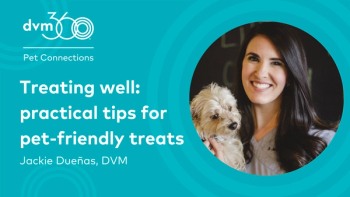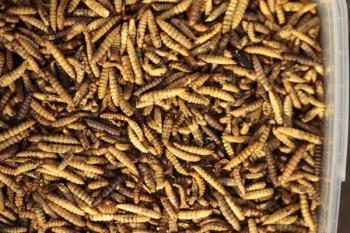
Senior diets: Do they live up to the hype?
Only have a few moments to discuss nutrition with senior pet clients? These veterinary nutrition pros have your talking points.
oksix/stock.adobe.comIs your client still feeding an adult maintenance diet to a senior pet? It's time for a conversation. We caught up with two veterinary nutrition experts, Joe Bartges, DVM, PhD, DACVIM, DACVN, professor of internal medicine and nutrition at the University of Georgia, and Ernie Ward, DVM, founder of the Association for Pet Obesity Prevention, for the latest on senior nutrition and how discussions with clients should go.
Like experts often do, they diverge in their opinions on some of the details, but on one point they are in complete agreement: nutrition is vital for the health of our senior veterinary patients.
Question: Do healthy senior dogs have different nutritional needs than healthy younger adult dogs? If so, what differences are most important?
Dr. Bartges: There are some known differences, but there's still a lot we don't know. For example, we know that older beagles require about 50 percent more protein to maintain muscle mass than younger beagles. However, in general there's no “senior nutritional profile” for all dogs. The three major things I think general practitioners (GPs) should keep in mind are:
Protein: Healthy older dogs need more protein than younger dogs. At the very least they don't need protein restriction. Keep in mind it's not only the amount of protein but the quality of the protein that's important-you can feed a lower quantity of a higher-biological-value protein and get the same nutrition.
Energy: It's incorrect to assume that dietary fat and therefore energy should be restricted. While some older dogs may require this, a diet should be individualized depending on how the dog is doing. Older dogs need enough energy to maintain body and muscle condition without becoming overweight. Typically, we calculate the resting energy requirement (RER) and multiply this by a factor for the maintenance energy requirement (MER). The factor used depends on reproductive status and activity. The more active a dog, the more energy it takes to maintain.
Omega-3 fatty acids: Because osteoarthritis is common in older patients, omega-3 fatty acids may be beneficial and may decrease the need for drug therapy. For dogs with arthritis, we typically administer 700 to 1,500 mg of the sum of EPA and DHA-not just total fatty acids. We use this sum because EPA and DHA are the specific omega-3 fatty acids that are incorporated into cell membranes and metabolized. It's important to avoid providing too much, which may cause diarrhea, vomiting and possibly bleeding issues.
Dr. Ward: First, there's no simple rule of thumb based on age-each individual animal will require nutrition based on its particular genetics lifestyle, and medical history. But in general, the scientific evidence is clear that dietary metabolic needs change as dogs age. Protein digestibility is one factor that's affected. We have to watch calories, but we still want to maintain adequate protein that's highly bioavailable and digestible.
How much protein? It depends on how much the dog is eating. My experience involves weight loss and treating obesity. If a dog is eating well (ample volume), a lower-protein formulation may be sufficient. But in general, higher-protein diets are associated with improved weight loss and maintenance of lean muscle mass. I think there's sufficient evidence to support 28 to 32 percent protein on a dry-matter basis (DMB) for healthy older dogs, especially if weight loss is needed.
Q: How about cats?
Dr. Bartges: Similar to older dogs, nutrition should be individualized and not prescriptive. Approximately 20 percent of older cats have decreased digestibility, but this means 80 percent don't. As with dogs, there are no published nutrient profiles for older cats; however, nutritional requirements for cats appear less likely to change with aging when compared with dogs.
Dr. Ward: With protein digestibility, the evidence is clear that cats need higher protein levels as they age. When cats start reaching age 10 or so, that's when protein digestibility drops off the cliff, so to speak. That's why we're seeing senior cat formulations in the marketplace with higher protein levels than we're used to-some of the more responsible pet food manufacturers are addressing senior feline needs.
There's some evidence (and my experience) that cats may benefit from about 5g/kg/day protein to lose or maintain weight. And if we're worried about kidneys, we actually need to watch phosphorus levels more closely than crude protein. Studies have shown older cats to have decreased fat and protein digestibility, requiring higher MER.
Bottom line, “Feed to the patient, not the chart” is the advice I most often provide. In simple terms, I advocate for lower-calorie, higher-protein diets for adult and senior weight-loss patients and in older cats that are inexplicably losing weight or showing decreased appetite.
Q: When it comes to senior nutrition, what's the most important thing GPs should know about, and how can we communicate that to our clients?
Dr. Bartges: Age is not a disease and nutrition should be individualized. Some older dogs require less protein, some more; some need less fat and energy while others need more; some need more fiber while some need less, and so on. Just because a dog or cat is 15 doesn't mean it needs a “senior” diet-it depends on the dog's activity, metabolism and health status.
Dr. Ward: The thing I emphasize is the life stage claim. I want to make sure the food clients are feeding has a claim that it's especially formulated for senior pets. I tell pet owners that's the first thing we'll look at because there are regulations around those terms. If a diet says it's for senior pets, it's going to have a slightly different formulation than a growth or adult maintenance diet.
The other thing I tell a pet owners to look for is a diet that contains antioxidants and immune-boosting supplementation. In addition to appropriate levels of protein, fat and carbohydrate, I'm looking for additional elements or ingredients in the diet that might give an additional medical benefit.
Q: What are the most common nutritional challenges senior dogs and cats experience?
Dr. Ward: Without a doubt it's low protein. As protein metabolism changes with age, pets begin to lose lean muscle mass, which is a serious issue. If they're losing lean muscle mass when they're 10, 12 or 13 years of age, they're getting weaker and weaker. By the time they're 13 to 15, cats can't get in the litter box and may be peeing on the carpet, or the dog may struggle to go up the steps. So it's really important to preserve lean muscle mass. I think the biggest mistake I see clinically is that clients are feeding an adult maintenance diet that has slightly lower protein levels than I'd like for a senior pet.
Q: What's the most common nutritional imbalance you see in senior dogs and cats?
Dr. Bartges: Weight loss and muscle mass loss. Unless there's a health condition necessitating it, protein and energy restriction is not necessary and some older patients actually require higher protein intake.
Q: What diseases can we help minimize or prevent with proper nutrition in senior dogs and cats?
Dr. Bartges: Good nutrition is important in all aspects of life; however, we know little in terms of preventing disease with nutrition and even what “proper” nutrition really means. Much of what we do is more reactive with our nutritional recommendations. For example, my patient has gastrointestinal disease so I change the diet to a novel or hydrolyzed protein. Or I use “joint diets” in young-adult large- and giant-breed dogs because of the risk of osteoarthritis later.
Dr. Ward: This is the big question everybody wants to know the answer to. Adding or changing protein sources, or adding different botanicals and nutritional supplements- quite frankly, we just don't have clear evidence for the benefit, but certainly we have trends toward benefits.
What we do have are two benchmark studies, one by Waltham and one by Purina, that looked at a lifetime of nutrition in dogs. What they found was one common denominator-that caloric restriction improved longevity and quality of life and reduced comorbidities. Whenever I talk to pet owners, the first thing I say is that nutrition should help extend the longevity and quality of life, and that starts by maintaining a healthy weight.
Q: At what age do you recommend GPs start counseling their clients that their pets' nutritional needs may be changing? Is it different for dogs versus cats?
Dr. Bartges: At every examination starting with the first examination. Nutritional assessment should be done on every patient and nutritional recommendations made on those assessments. There are good resources available, such as AAHA's
Dr. Ward: I structure this discussion in three phases. The first phase is puppy- or kittenhood. You want to communicate to pet owners that as their puppy or kitten grows and ages, we're going to change the diet to match the life stage. The first year of life we have a special formulation that helps them grow strong bones, develop a healthy immune system and brain, and so forth. The second phase is the adult maintenance stage, and then the senior stage. If you start positioning the message early that there will be diet changes, then you'll be more successful with your diet recommendations.
For cats, I prep clients to switch to a senior diet around age 9 to 10 because that's when I believe the physiological changes really set in. For most dogs, I'm OK with the seven-year switch. With some small breeds you can wait till age 9 or 10, but the reality is somewhere around age 7 you need to be having that conversation with dog owners.
One of the things veterinarians can do is use their reminder system to send a special birthday message on the 7th or 9th birthday that says, “Happy birthday and congratulations on the age milestone! Here are a few things to look out for, including changes in nutrition.”
Q: What advances in senior nutrition are exciting to you, and how will those impact GPs and pet health?
Dr. Bartges: There are several-particularly the benefits of omega-3 fatty acids, probiotics and utilization of therapeutic diets for prevention and early intervention versus their standard use when a disease is clinically evident.
Q: Can GPs draw parallels to senior nutrition in humans to help drive home the point and build an association for their clients? If so, do you have any easy ways to communicate that?
Dr. Bartges: While this approach is tempting, it's not always comparable or accurate. I prefer to discuss the individual pet in a patient-centered approach and use humans for comparison to illustrate points, including those that are similar and those that are not.
Dr. Ward: When it comes to counseling clients about senior nutrition needs, I wouldn't shy away from the menopause analogy. That's what I've always used because humans have been taught since we were young that a change of life is going to occur. Obviously I'm a male, but still, I'm exposed to that. It's a salient point because it's a physiological hormonal and cellular change that you can't see-but you sure can see the effects. It's the same thing for aging dogs and cats. The system isn't probably as robust as it once was with all those little things we can't see, and we can try to meet additional needs with nutrition. This will really make the lightbulb in your client's head light up!
Dr. Sarah Wooten is an associate veterinarian in Greeley, Colorado, and a speaker at the Fetch dvm360 conferences.
Newsletter
From exam room tips to practice management insights, get trusted veterinary news delivered straight to your inbox—subscribe to dvm360.






